|
|
|
|
Contact:
|
DIY Windscreen/Potstand - Old School
Cone Shaped Windscreen-Potstands
Charcoal Starters - related ideas
|
Here are just a few methods of making a potstand for your stove and pot. Please view our PotStand Parent Page for an intro of other options.
This allows you to set a Type I Can-Pot directly on your stove without the need of a pot stand.
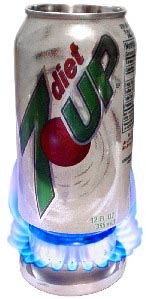
Construction -
Simply cut out a rectangular piece of can sidewall or aluminum flashing to about the same length as your inner tube (the max length from a 12oz can sidewall would be ideal) and about 1-2mm wider.
Roll it up and stick it in your stove.
Test placing your Can-Pot on your stove and trim as necessary.
You can cut locking slits in your adapter to strengthen it but it must be perfectly set up and you'll end up with more sharp corners than you had before (unless you epoxy them down or round them off). Epoxying it into a solid cylinder, punching three weep holes on the bottom edge, and/or sealing it to the stove with JB weld or RTV are also optional but not required.
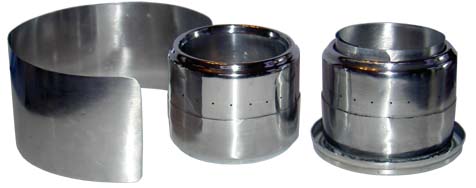
The Type I Can-Pot made from a 12oz can may not fit tightly on a stove made of 6oz cans with the adapter above, but the adapter should hold the pot enough that it won't fall off while boiling. Play with it until you are comfortable enough to take it backpacking, as it doesn't look like a good idea at first, but it does work.
If you wish to use a 24oz Type I Can-Pot (such as a large Heineken can) with a larger diameter bottom depression, you can simply cut out a disc (see templates) from aluminum flashing or steel shim and force/set it into the depression. Another option is to cut out the bottom of a 3oz Spam Spread can and use it like the disc, which will fit perfectly. Either option will create a flat surface that will allow you to use a sideburner stove made from 12oz and 6oz cans. You may try to glue the adapter into the bottom of your Can-Pot if you like or just consider flipping the can over and making an inverted Type II Can-Pot instead.
If you want to get fancy, you can cut out the bottom of a 7oz Sterno can and fit it over the bottom of a Heineken can to make a nice flat surface. Or, you can use some pegs and a hammer to flatten out the bottom depression (it would be so much easier to cut the bottom of the can off and flip it over).
Hammer or Press Technique
With a bit of patience and effort, you can flatten or recurve the bottom of your can so that it better sits on a stove or potstand.
1897 US Patent 584,162
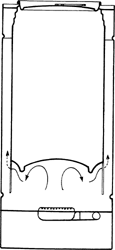
1994 US Patent 5,373,836
Potstands for cans and bottles have actually been around for a long time. And given the narrow width and small bottom surface area, an approach to heating a bottle or can may be to focus on concentrating heat around the side of the bottle or can instead of just the bottom of the can.

If you are using solid fuel tabs to cook with or wish to have something more stable and efficient than a Can-Pot Adapter, you can make a simple stand from a sheet of steel. A suitable sheet can be found in hobby stores (Easy Solder Tin), specialty metal stores (0.005 to 0.010 steel or stainless shim stock) or from an empty denatured alcohol can sidewall. Simply tape your template onto your sheet, punch out the holes (you will need a heavy duty punch, arch punch or drill), cut it out, test fit (can bottoms very from can to can), drill the rivet holes (unless you opt to use the tabs), roll in the overlapping edge just a bit for athletics, and rivet shut. Welded wire (don't use galvanized wire because of heavy metal poisoning concerns) can be substituted for sheet metal but isn't as solid and will have many sharp edges that that should be filed down if you wish to avoid future cuts on you and/or your gear while out on the trail.
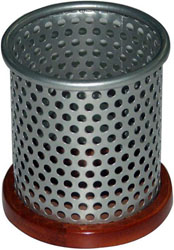
And if you are lucky, you may be able to find a fancy stainless pencil holder with holes already punched out. You can trim it to the right height. And if it is too wide, you can cut and decrease its diameter so it fits just right.

There are two different sized stands provided on the templates page. The smaller one design is only suitable for use with Can-Pots made from 12oz and 8oz cans. Due to its narrow diameter, you will be restricted to using solid fuel tabs, candles and alcohol stoves the size of tealights. And if you get creative, you can convert your stand into a stove.

A stand with a larger diameter is required for use with 24oz Heineken and Fosters Can-Pots and also works well with ones made of 12oz and 8oz cans and regular pots. These larger stands are wide enough to fit an alcohol topburner mini-stove made from 6oz cans (top and bottom section 20mm tall and inner wall 30mm) if you use short rivets, file them down or just use fold over tabs in lieu of rivets. A nice fitting base for the large Can-Pot stand can be made from a bottom of 3oz can of cat food.
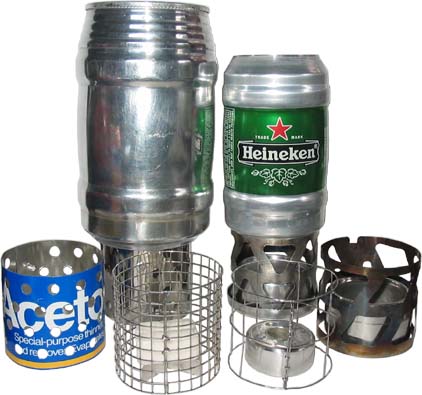
|
Weights for large Can-Pot Stand |
||
|
|
oz |
gm |
|
Side of solvent can (0.012") |
0.7 |
19 |
|
0.010" steel shim |
0.6 |
18 |
|
Easy Solder Tin (0.009") |
0.6 |
16 |
|
Stainless Steel Welded Wire (0.032") 1/4" Mesh (4x4) - 9x28 squares |
0.5 |
13 |
|
0.005" stainless shim with rivets |
0.4 |
10 |
|
0.005" stainless shim without rivets |
0.4 |
10 |
|
Trimmed Stainless Steel Welded Wire (0.032") 1/2" Mesh (2x2) - 4x14 squares + one 1/4" row |
0.3 |
8 |
|
0.003" stainless shim without rivets "Opened" 3 holes connected |
0.3 |
7 |
|
0.005" stainless shim without rivets (seems flimsy but surprisingly resilient) |
0.2 |
6 |
|
aluminum flashing (questionable heat resistance - not recommended) |
0.2 |
6 |
|
Trimmed Stainless Steel Welded Wire (0.032") 1" Mesh (1x1) - 2x7 squares |
0.1 |
4 |
|
0.003" stainless shim without rivets "Opened" 4 holes connected |
0.1 |
4 |
|
"Opened" 0.005" stainless shim 3 holes connected |
"Opened" 0.003" stainless shim 4 holes connected |
Note for Alcohol stove use - You may need more ventilation in your stand if you are using an alcohol stove. Either "open" up your stand by removing metal from between some of the holes or use welded stainless wire (not galvanized).
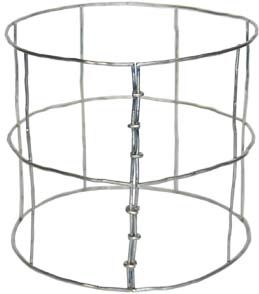
Trimmed Stainless Steel Welded Wire (0.032") with 3 out of 4 wires removed
Welded wire isn't as resilient as sheet metal and you may want to soldering, weld or tie the ends together so that it doesn't collapse when a Can-Pot is placed on it. You can also trim off a considerable percentage of weight by removing extra supports from the welded wire. To avoid creating possibly hundreds of wire remnants with sharp points, instead of using wire snips, break the welds by grabbing the wire to be removed at the weld and twisting back and forth until the weld pops.
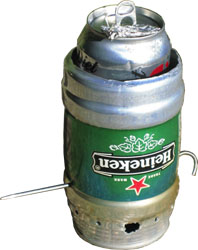
Related Links:
backpackinglight.com 5975 - Inverted Heineken pot used as stand and windscreen for smaller CanPot
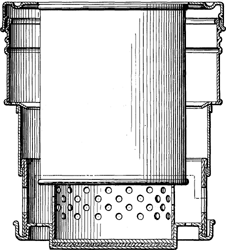
1950 US Patent 2,607,334
Related Stove Patent 2,530,721
Here is a 1950's SuperCat stove heating a can of food
CanPot Stove related US Patents:
538,056 - Bottle stand with contoured vented windscreen
732,936 - bottle holder
1,147,856 - glass holder hugs side of glass
1,276,905 - Hanging rack for bottle of can - possible to make rack of wire, rod or fiberglass wick to hang from windscreen - related hanger: D541564
1,307,482 - Multiple can holder - easy design to make a single can holder
1,325,515 - Can with built in stand
1,354,409 - crazy bottle stand
1,399,866 - double walled stand holds long narrow can by upper rim
1,485,159 - bottle holder for heating
2,036,611 - self-contained food can with stand and cardboard grasper
2,537,439 - Cone shaped windscreen for baby bottle
2,584,040 - all in one canned food and stove
2,607,334 -SuperCat with collapsible windscreen
2,722,214 - bottle with cup and retractable stand
2,801,627 - CanPot/stove combination
2,936,144 - bottle holder
3,120,226 - Plastic fuel is wrapped around can
3,145,706 - Bendable tab supports
3,262,445 - Sideburner stove
3,357,669 - Rug protector - cut hole in center and you have a simple potstand
3,369,538 - Can with built in stand and Sterno can
3,430,623 - Another can with built in stand
3,502,068 - split can to may tripod stand
3,566,857 - Self-contained canned food and heater
3,726,268 - Sterno stove for canned food
4,134,385 - Ring with bent tabs
4,424,798 - can with built in stand/stove
5,373,836 - corrugated bottom with sides and vented top for beverage can
Since a great deal of heat is lost going out past the narrow bottom of the Can-Pot, a more efficient alcohol system might be constructed by decreasing the heat output and redirecting the flames to concentrate at the bottom center of the pot. You might want to consider using a Tealight Stove. Another option is to make a pressurized mini stove (top and bottom section 20mm tall with/without a 30mm inner wall) with its jets positioned around the inner ring of the stove angled in at 45°. A primer pan made form a 3oz cat food can should allow a large Can-Pot stand and mini stove to fit snugly on it. Twenty-four holes with a #71 drill puts out way too much heat.
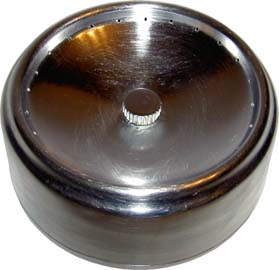
Mini Pressurized Stove with all its jets focused at one central point
This one by Captain Paranoia uses a conic-walled burner which allows for a open jet stove with inner facing jets. It uses 12 x 0.6mm holes which direct pressurized gasified alcohol inward.
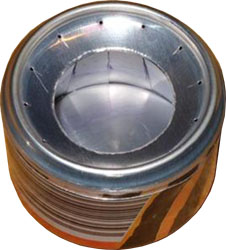
Captain Paranoia's Conic-Walled Burner
If you want to use the 24oz Heineken can or a Fosters can as a pot, you can make a stove designed specifically for that.

|
The main portion of this stove is made from a 3oz Hormel Spam Spread can. It has been left mostly intact, with a fuel port hole cut in the bottom and jets drilled in the side.
Inner cylinder is 19mm wide.
28 holes 15mm from top of the stove drilled with #71 drill (needle size).
Heineken can bottoms fit perfectly around the rim and regular pots and pans can be placed on top of stove.
For details see - Zen Stove and Simplified Zen Stove. |
|
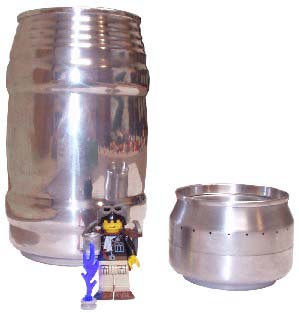
|
Top portion of stove is a top from a Guinness can with the inner most circular crease scored and cut out. Epoxied and centered is a circular ridge from the bottom of a Coke can (center depression cut out and everything below bottom of outside ridge cut away). 30mm tall.
Inner cylinder is 40mm wide
Bottom is an unstretched Pepsi can (fits snugly over top part) 20mm tall.
24 holes 15mm from top of can drilled with #57 drill (pushpin size). Note - if you want more heat output, you may want to drill your holes just a bit more than 15mm from the top of your can.
The Guinness can is noticeably thicker than regular 12oz cans and should add weight and presumably strength to your stove (especially if you use the side wall for the inner chamber wall).
Heineken can bottoms fit perfectly around the rim and most 12oz can bottoms fit inside the rim. Pots and pans can be placed on top of stove. |
|
|
Very important - J-B weld is not a suitable epoxy for epoxying the top adapter and will burn off after the fist couple of uses.
Top portion is a rim from an Albertson's Root Beer can (rim has about the same dimensions as a Guinness top) with the innermost circular crease scored (from inside of can with a knife) and removed. The side of can was scored at its highest point and removed. This is epoxied to the top of the stove and carefully centered.
Stove made from two 6oz V-8 cans. 30mm top and 20mm bottom. Bottom was stretched over two cans (a tool made of one unopened can with an empty can stretched over it).
Inner cylinder is 40mm wide.
The unnecessary stove base is a bottom from a Coke can (ridge cut off with stove slipped tightly in hole) epoxied to the side of stove. This adds some stability, weight and bulk to the stove.
Like its big brother, Heineken can bottoms fit perfectly around the rim and most 12oz can bottoms fit inside the rim. Pots and pans can be placed on top of stove. |
|
When all is done, you should have a 1oz cook system (2oz if you use the 24oz Heineken can).